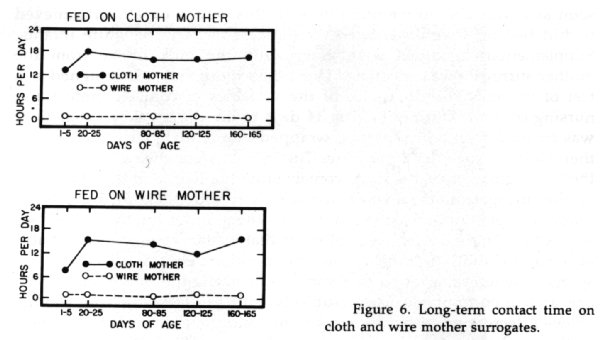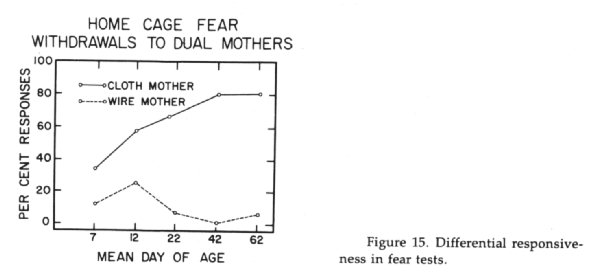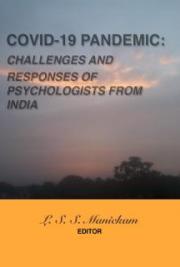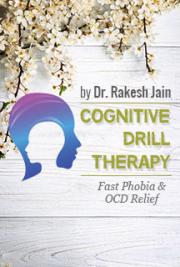The Nature of Love
Harry F. Harlow (1958)[1]
Classics in the History of Psychology
An internet resource developed by
Christopher D. Green
York University, Toronto, Ontario
ISSN 1492-3173
(Return to C
lassics index )
The Nature of Love
Harry F. Harlow (1958)[1]
University of Wisconsin
Posted March 2000
Address of the President at the sixty-sixth Annual Convention of the American Psychological Association, Washington, D. C., August 31, 1958.
First published in American Psychologist, 13, 573-685.
Love is a wondrous state, deep, tender, and rewarding. Because of its intimate and personal nature it is regarded by some as an improper topic for experimental research. But, whatever our personal feelings may be, our assigned mission as psychologists is to analyze al facets of human and animal behavior into their component variables. So far as love or affection is concerned, psychologists have failed in this mission. The little we know about love does not transcend simple observation, and the little we write about it has been written better by poets and novelists. But of greater concern is the fact that psychologists tend to give progressively less attention to a motive which pervades our entire lives. Psychologists, at least psychologists who write textbooks, not only show no interest in the origin and development of love or affection, but they seem to be unaware of its very existence.
The apparent repression of love by modem psychologists stands in sharp contrast with the attitude taken by many famous and normal people. The word "love" has the highest reference frequency of any word cited in Bartlett's book of Familiar Quotations. It would appear that this emotion has long had a vast interest and fascination for human beings, regardless of the attitude taken by psychologists; but the quotations cited, even by famous and normal people, have a mundane redundancy. These authors and authorities have stolen love from the child and infant and made it the exclusive property of the adolescent and adult.
Thoughtful men, and probably all women, have speculated on the nature of love. From the developmental point of view, the general plan is quite clear: The initial love responses of the human being are those made by the infant to the mother or some mother surrogate. From this intimate attachment of the child to the mother, multiple learned and generalized affectional responses are formed.
Unfortunately, beyond these simple facts we know little about the fundamental variables underlying the formation of affectional responses and little about the mechanisms through which the love of the infant for the mother develops into the multifaceted response patterns characterizing love or affection in the adult. Because of the dearth of experimentation, theories about the fundamental nature of affection have evolved at the level of observation, intuition, and discerning guesswork, whether these have been proposed by psychologists, sociologists, anthropologists, physicians, or psychoanalysts.
The position commonly held by psychologists and sociologists is quite clear: The basic motives are, for the most part, the primary drives -- particularly hunger, thirst, elimination, pain, and sex
-- and all other motives, including love or affection, are derived or secondary drives. The mother is associated with the reduction of the primary drives -- particularly hunger, thirst, and pain --
and through learning, affection or love is derived.
It is entirely reasonable to believe that the mother through association with food may become a secondary-reinforcing agent, but this is an inadequate mechanism to account for the persistence of the infant-maternal ties. There is a spate of researches on the formation of secondary reinforcers to hunger and thirst reduction. There can be no question that almost any external stimulus can become a secondary reinforcer if properly associated with tissue-need reduction, but the fact remains that this redundant literature demonstrates unequivocally that such derived drives suffer relatively rapid experimental extinction. Contrariwise, human affection does not extinguish when the mother ceases to have intimate association with the drives in question. Instead, the affectional ties to the mother show a lifelong, unrelenting persistence and, even more surprising, widely expanding generality.
Oddly enough, one of the few psychologists who took a position counter to modern psychological dogma was John B. Watson, who believed that love was an innate emotion elicited by cutaneous stimulation of the erogenous zones. But experimental psychologists, with their peculiar propensity to discover facts that are not true, brushed this theory aside by demonstrating that the human neonate had no differentiable emotions, and they established a fundamental psychological law that prophets are without honor in their own profession.
The psychoanalysts have concerned themselves with the problem of the nature of the development of love in the neonate and infant, using ill and aging human beings as subjects.
They have discovered the overwhelming importance of the breast and related this to the oral erotic tendencies developed at an age preceding their subjects' memories. Their theories range from a belief that the infant has an innate need to achieve and suckle at the breast to beliefs not unlike commonly accepted psychological theories. There are exceptions, as seen in the recent writings of John Bowlby, who attributes importance not only to food and thirst satisfaction, but also to "primary object-clinging," a need for intimate physical contact, which is initially associated with the mother.
As far as I know, there exists no direct experimental analysis of the relative importance of the stimulus variables determining the affectional or love responses in the neonatal and infant primate. Unfortunately, the human neonate is a limited experimental subject for such researches because of his inadequate motor capabilities. By the time the human infant's motor responses can be precisely measured, the antecedent determining conditions cannot be defined, having been lost in a jumble and jungle of confounded variables.
Many of these difficulties can be resolved by the use of the neonatal and infant macaque monkey as the subject for the analysis of basic affectional variables. It is possible to make precise measurements in this primate beginning at two to ten days of age, depending upon the maturational status of the individual animal at birth. The macaque infant differs from the human infant in that the monkey is more mature at birth and grows more rapidly; but the basic responses relating to affection, including nursing, contact, clinging, and even visual and auditory exploration, exhibit no fundamental differences in the two species. Even the development of perception, fear, frustration, and learning capability follows very similar sequences in rhesus monkeys and human children.


Three years' experimentation before we started our studies on affection gave us experience with the neonatal monkey. We had separated more than 60 of these animals from their mothers 6 to 12 hours after birth and suckled them on tiny bottles. The infant mortality was only a small fraction of what would have obtained had we let the monkey mothers raise their infants. Our bottle-fed babies were healthier and heavier than monkey-mother-reared infants. We know that we are better monkey mothers than are real monkey mothers thanks to synthetic diets, vitamins, iron extracts, penicillin, chloromycetin, 5% glucose, and constant, tender, loving care.
During the course of these studies we noticed that the laboratory raised babies showed strong attachment to the cloth pads (folded gauze diapers) which were used to cover the hardware-cloth floors of their cages. The infants clung to these pads and engaged in violet temper tantrums when the pads were removed and replaced for sanitary reasons. Such contact-need or responsiveness had been reported previously by Gertrude van Wagenen for the monkey and by Thomas McCulloch and George Haslerud for the chimpanzee and is reminiscent of the devotion often exhibited by human infants to their pillows, blankets, and soft, cuddly stuffed toys. Responsiveness by the one-day-old infant monkey to the cloth pad is shown in Figure 1, and an unusual and strong attachment of a six-month-old infant to the cloth pad is illustrated in Figure 2. The baby, human or monkey, if it is to survive, must clutch at more than a straw.
We had also discovered during some allied observational studies that a baby monkey raised on a bare wire-mesh cage floor survives with difficulty, if at all, during the first five days of life. If a wire-mesh cone is introduced, the baby does better; and, if the cone is covered with terry cloth, husky, healthy, happy babies evolve. It takes more than a baby and a box to make a normal monkey. We were impressed by the possibility that, above and beyond the bubbling fountain of breast or bottle, contact comfort might be a very important variable in the development of the infant's affection for the mother.

At this point we decided to
study the development of
affectional responses of
neonatal and infant monkeys
to an artificial, inanimate
mother, and so we built a
surrogate mother which we
hoped and believed would be
a good surrogate mother. In
devising this surrogate mother
we were dependent neither
upon the capriciousness of
evolutionary processes nor
upon mutations produced by
chance radioactive fallout.
Instead, we designed the
mother surrogate in terms of
modem human engineering
principles (Figure 3). We
produced
a
perfectly
proportioned,
streamlined
body stripped of unnecessary
bulges and appendices.
Redundancy in the surrogate
mother's system was avoided
by reducing the number of
breasts from two to one and
placing this unibreast in an
upper-thoracic,
sagittal
position, thus maximizing the
natural and known perceptual-
motor capabilities of the infant
operator. The surrogate was made from a block of wood, covered with sponge rubber, and sheathed in tan cotton terry cloth. A light bulb behind her radiated heat. The result was a mother, soft, warm, and tender, a mother with infinite patience, a mother available twenty-four hours a day, a mother that never scolded her infant and never struck or bit her baby in anger.
Furthermore, we designed a mother-machine with maximal maintenance efficiency since failure of any system or function could be resolved by the simple substitution of black boxes and new component parts. It is our opinion that we engineered a very superior monkey mother, although this position is not held universally by the monkey fathers.
Before beginning our initial experiment we also designed and constructed a second mother surrogate, a surrogate in which we deliberately built less than the maximal capability for contact comfort. This surrogate mother is illustrated in Figure 4. She is made of wire-mesh, a substance entirely adequate to provide postural support and nursing capability, and she is warmed by radiant heat. Her body differs in no essential way from that of the cloth mother surrogate other than in the quality of the contact comfort which she can supply. In our initial experiment, the dual mother-surrogate condition, a cloth mother and a wire mother were placed in different cubicles attached to the infant's living cage as shown in Figure 4. For four newborn monkeys the cloth mother lactated and the wire mother did not; and, for the other four, this condition was reversed. In either condition the infant received al its milk through the mother surrogate as soon as it was able to maintain itself in this way, a capability achieved within two or three days except in the case of very immature infants. Supplementary feedings were given until the milk intake from the mother surrogate was adequate. Thus, the experiment was designed as a test of the relative importance of the variables of contact comfort and nursing comfort. During the first 14 days of life the monkey's cage floor was covered with a heating pad wrapped in a folded gauze diaper, and thereafter the cage floor was bare. The infants were always free to leave the heating pad or cage floor to contact either mother, and the time spent on the surrogate mothers was automatically recorded. Figure 5 shows the total time spent cloth


and wire mothers under the
two conditions of feeding.
These data make it obvious
that contact comfort is a
variable of overwhelming
importance
in
the
development of affectional
response, whereas lactation is
a variable of negligible
importance. With age and
opportunity to learn, subjects
with the lactating wire mother
showed
decreasing
responsiveness to her and
increasing responsiveness to
the nonlactating cloth mother,
a finding completely contrary
to any interpretation of derived
drive in which the mother-form
becomes conditioned to
hunger-thirst reduction. The
persistence
of
these
differential
responses
throughout 165 consecutive days of testing is evident in Figure 6.

One control group of neonatal monkeys was raised on a single wire mother, and a second control group was raised on a single cloth mother. There were no differences between these two groups in amount of milk ingested or in weight gain. The only difference between the two groups lay in the composition of the feces, the softer stools of the wire-mother infants suggesting psychosomatic involvement. The wire mother is biologically adequate but psychologically inept.
We were not surprised to discover that contact comfort was an important basic affectional or love variable, but we did not expect it to overshadow so completely the variable of nursing; indeed; indeed, the disparity is so great as to suggest that the primary function of nursing as an affectional variable is that of insuring frequent and intimate body contact of the infant with the mother. Certainly, man cannot live by milk alone. Love is an emotion that does not need to be bottle- or spoon-fed, and we may be sure that there is nothing to be gained by giving lip service to love.
A charming lady once heard me describe these experiments and, when I subsequently talked to her, her face brightened with sudden insight: "Now I know what's wrong with me," she said,
"I'm just a wire mother." Perhaps she was lucky. She might have been a wire wife.
We believe that contact comfort has long served the animal kingdom as a motivating agent for affectional responses. Since at the present time we have no experimental data to substantiate this position, we supply information which must be accepted, if at all, on the basis of face validity:






One function of the real mother, human or subhuman, and presumably of a mother surrogate, is to provide a haven of safety for the infant in times of fear and danger. The frightened or ailing child clings to its mother, not its father; and this selective responsiveness in times of distress, disturbance, or danger may be used as a measure of the strength of affectional bonds. We have tested this kind of differential responsiveness by presenting to the infants in their cages, in the presence of the two mothers, various fear-producing stimuli such as the moving toy bear illustrated in Figure 13. A typical response to a fear stimulus is shown in Figure 14, and the data on differential responsiveness are presented in Figure 15. It is apparent that the cloth mother is highly preferred over the wire one, and this differential selectivity is enhanced by age and experience. In this situation, the variable of nursing appears to be of absolutely no importance: the infant consistently seeks the soft mother surrogate regardless of nursing condition.



Similarly, the mother or mother surrogate provides its young with a source of security, and this role or function is seen with special clarity when mother and child are in a strange situation. At the present time we have completed tests for this relationship on four of our eight baby monkeys assigned to the dual mother-surrogate condition by introducing them for three minutes into the strange environment of a room measuring six feet by six feet by six feet (also called the
"open-field test") and containing multiple stimuli known to elicit curiosity-manipulatory responses in baby monkeys. The subjects were placed in this situation twice a week for eight weeks with no mother surrogate present during alternate sessions and the cloth mother present during the others. A cloth diaper was always available as one of the stimuli throughout all sessions. After one or two adaptation sessions, the infants always rushed to the mother surrogate when she was present and clutched her, rubbed their bodies against her, and frequently manipulated her body and face. After a few additional sessions, the infants began to

use the mother surrogate as a source of security, a base of operations. As is shown in Figures 16 and 17, they would explore and manipulate a stimulus and then return to the mother before adventuring again into the strange new world. The behavior of these infants was quite different when the mother was absent from the room. Frequently they would freeze in a crouched position, as is illustrated in Figures 18 and 19. Emotionality indices such as vocalization, crouching, rocking, and sucking increased sharply, as shown in Figure 20. Total emotionality score was cut in half when the mother was present. In the absence of the mother some of the experimental monkeys would rush to the center of the room where the mother was customarily placed and then run rapidly from object to object, screaming and crying all the while.
Continuous, frantic clutching of their bodies was very common, even when not in the crouching position. These monkeys frequently contacted and clutched the cloth diaper, but this action never pacified them. The same behavior occurred in the presence of the wire mother. No difference between the cloth-mother-fed and wire-mother-fed infants was demonstrated under either condition. Four control infants never raised with a mother surrogate showed the same emotionality scores when the mother was absent as the experimental infants showed in the absence of the mother, but the controls' scores were slightly larger in the presence of the mother surrogate than in her absence.




Some years ago Robert Butler demonstrated that mature monkeys enclosed in a dimly lighted box would open and reopen a door hour after hour for no other reward than that of looking outside the box. We now have data indicating that neonatal monkeys show this same compulsive visual curiosity on their first test day in an adaptation of the Butler apparatus which we call the "love machine," an apparatus designed to measure love. Usually these tests are begun when the monkey is 10 days of age, but this same persistent visual exploration has been obtained in a three-day-old monkey during the first half-hour of testing. Butler also demonstrated that rhesus monkeys show selectivity in rate and frequency of door-opening to stimuli of differential attractiveness in the visual field outside the box. We have utilized this principle of response selectivity by the monkey to measure strength of affectional responsiveness in our infants in the baby version of the Butler box. The test sequence involves four repetitions of a test battery in which four stimuli -- cloth mother, wire mother, infant monkey, and empty box -- are presented for a 30-minute period on successive days. The first four subjects in the dual mother-surrogate group were given a single test sequence at 40 to 50
days of age, depending upon the availability of the apparatus, and only their data are presented. The second set of four subjects is being given repetitive tests to obtain information relating to the development of visual exploration. The apparatus is illustrated in Figure 21. The data obtained from the first four infants raised with the two mother surrogates are presented in the middle graph of Figure 22 and show approximately equal responding to the cloth mother and another infant monkey, and no greater responsiveness to the wire mother than to an empty box. Again, the results are independent of the kind of mother that lactated, cloth or wire. The same results are found for a control group raised, but not fed, on a single cloth mother; these data appear in the graph on the right. Contrariwise, the graph on the left shows no differential responsiveness to cloth and wire mothers by a second control group, which was not raised on


any mother surrogate. We can
be certain that not all love is
blind.
The first four infant monkeys in the dual mother-surrogate group were separated from their mothers between 165 and 170 days of age and tested for retention during the following 9 days and then at 30-day intervals for six successive months. Affectional retention as measured by the modified Butler box is given in Figure 23. In keeping with the data obtained on adult monkeys by Butler, we find a high rate of responding to any stimulus, even the empty box. But throughout the entire 185-day retention period there is a consistent and significant difference in

response frequency to the cloth mother contrasted with either the wire mother or the empty box, and no consistent difference between wire mother and empty box.
Affectional retention was also tested in the open field during the first 9 days after separation and then at 30-day intervals, and each test condition was run twice at each retention interval.
The infant's behavior differed from that observed during the period preceding separation. When the cloth mother was present in the post-separation period, the babies rushed to her, climbed up, clung tightly to her, and rubbed their heads and faces against her body. After this initial embrace and reunion, they played on the mother, including biting and tearing at her cloth cover; but they rarely made any attempt to leave her during the test period, nor did they manipulate or play with the objects in the room, in contrast with their behavior before maternal separation.
The only exception was the occasional monkey that left the mother surrogate momentarily, grasped the folded piece of paper (one of the standard stimuli in the field), and brought it quickly back to the mother. It appeared that deprivation had enhanced the tie to the mother and rendered the contact-comfort need so prepotent that need for the mother overwhelmed the exploratory motives during the brief, three-minute test sessions. No change in these behaviors was observed throughout the 185-day period. When the mother was absent from the open field, the behavior of the infants was similar in the initial retention test to that during the preseparation tests; but they tended to show gradual adaptation to the open-field situation with repeated testing and, consequently, a reduction in their emotionality scores.
In the last five retention test periods, an additional test was introduced in which the surrogate mother was placed in the center of the room and covered with a clear Plexiglas box. The monkeys were initially disturbed and frustrated when their explorations and manipulations of the box failed to provide contact with the mother. However, all animals adapted to the situation rather rapidly. Soon they used the box as a place of orientation for exploratory and play behavior, made frequent contacts with the objects in the field, and very often brought these objects to the Plexiglas box. The emotionality index was slightly higher than in the condition of the available cloth mothers, but it in no way approached the emotionality level displayed when the cloth mother was absent. Obviously, the infant monkeys gained emotional security by the presence of the mother even though contact was denied.
Affectional retention has also been measured by tests in which the monkey must unfasten a three-device mechanical puzzle to obtain entrance into a compartment containing the mother surrogate. All the trials are initiated by allowing the infant to go through an unlocked door, and in half the trials it finds the mother present and in half, an empty compartment. The door is then locked and a ten-minute test conducted. In tests given prior to separation from the surrogate mothers, some of the infants had solved this puzzle and others had failed. The data of Figure 24 show that on the last test before separation there were no differences in total manipulation under mother-present and mother-absent conditions, but striking differences exist between the two conditions t






























